How to Make Your Own Career Roadmap (With Templates)
Whether you're looking to advance your skills or move up the career ladder, a career roadmap can help you create an effective growth plan. Here's how!
Achieving some goals takes more than determination and a few right steps. A solid plan in advance can lay out your necessary milestones, while giving you a clear path to follow.
Career roadmaps are a common practice, used by individuals and whole businesses. They help professionals advance their skills and achievements, whether as freelancers or employees.
Follow the tips below to create the most efficient plan for your career goals. You will need to do some research and keep updating the roadmap as you progress, but the outcome is worth the effort.

What Is a Career Roadmap, and Why Make One?
A career roadmap is a visual representation of the steps you need to take to reach a professional goal, such as a high-ranking position in an organization or just a better job title. Basically, you put down your starting point and what you want to achieve. Then, you plan out how to get from A to B. You can do this alone or get help from your employer.
In fact, opportunities for advancement in the workplace are growing in demand. Statistics on SurveyMonkey show that 37 percent of employees want more options on offer. However, 86 percent found they had plenty of control over their tasks, methods, and timing.
So, the freedom to act on your roadmap is already there. All that remains is for the professional landscape to introduce more ways to advance your career.
And a roadmap is a perfect excuse to explore your options and put the best milestones in order. Additionally, it gives you a clear and practical vision of your future, showing you that it’s entirely possible to reach. Stick to the plan and use different methods to stop forgetting things at work . Day by day, step by step, your dream can become a reality.
How to Make a Career Roadmap
Start with a simple layout and branch out as necessary. Keep your timeline and other everyday responsibilities in mind as you put your career roadmap together.
1. Define Your Starting Point
Your current position in an organization can serve as your map’s beginning. If you’re applying for a new job, that can also be your starting point. It depends on what your goal is. Do you want a promotion? Or are you a freelancer wanting to upgrade your skillset and marketability?
Whether you’re balancing a full-time job and a side hustle or focusing on a single career path, decide what your roadmap’s point A is.
2. Define Your Career Goal and Its Requirements
Once you know where you’re coming from, set your end goal. It could be something already within your capabilities or a position you’ll need to strive for. Either way, make sure your target is realistic and based on good research.
If you work in fashion, for example, and dream of being an astronaut, your chances of success aren’t very high. But you could aim for a position as a spacesuit designer—still a challenge, but likelier to pan out with excellent planning and dedication.
So, while setting your career roadmap’s goal, look into its requirements, too. Establish if it’s a good direction for you and prepare to lay out how you’ll get there.
3. Add Steps to Connect Your Roadmap’s Beginning and End
You have a starting point and a goal. Now, you need to set your steppingstones. Start with major targets you’ll need to reach, like qualifications, work experience, and where you’d get these. Will you need to relocate? How much will this professional journey cost?
At the same time, work out how long each step will take and where it fits on your timeline. The more precise you can make it, the less you’ll need to adjust your journey later. That’s why research and realistic expectations are important.
Between your key milestones, add smaller steps to guide you from one target to the next. These could include practicing a particular skill, joining a social group to make connections, or getting tools for different tasks.
Exploring expense tracking apps for Android can be as helpful as finding which colleges offer the degrees you need. Spend time on such matters, and your career roadmap will become richer in detail and potential.
4. Make Your Career Roadmap Engaging and Easy to Access
Filling your map with practical information and goals ensures that you have a sensible and exciting journey to look forward to. Something else that can help you visualize your future and enjoy the planning process is giving your roadmap character.
For example, you could color code it and spread it out, so you can add helpful notes or checklists under different milestones. On a digital career roadmap, attach files and add hyperlinks to important web pages.
If your employer or someone else is helping you, give them access to the document, so they can offer their input. Creating your own career roadmap doesn’t mean doing it alone.
Additionally, try to make it as easy as possible to interact with your map at any time. Here, digital files have the advantage as you can carry them on your phone or upload them to the cloud, so you can open them from any device.
5. Keep Your Career Roadmap Up to Date
Another tip to making an effective career roadmap is to never stop managing it. Tick those checklists as you go. Update that information. Recalculate your budgets and schedule.
You get to appreciate your progress so far, assess the rest of your journey, and deal with any surprises or even mistakes you made.
Templates for Career Roadmaps
It’s not just other people you can entrust your roadmap to. Software and websites can help as well with advice, tools, and templates. Here are some of the best options.
1. Google Docs
You can create your own career roadmap with help from the best Google Docs add-ons for creating diagrams . Otherwise, you can simply use the platform’s default Drawing tools, available in the Insert tab. It lets you create a new design or upload one from Google Drive.
2. Microsoft Office
The same strategy works on Word, PowerPoint, and Excel. They all have plenty of tools to draw your map from scratch, but you can try out their templates, too.
You’ll find different kinds of roadmaps, planners, and timelines that you can tweak to your liking. If your app lacks good options, explore Microsoft’s templates library for more.
4. Preceden
When it comes to software for making roadmaps and timelines, Preceden is one of the most reliable. Every feature is there to visualize and perfect your career plan.
From a blank slate to elaborate templates, from editing to sharing tools, rest assured you have everything you need, especially if you decide to upgrade from a free account.
Download: Preceden
5. Office Timeline
Here’s one more app you should know about that can help you plan your career. Keep in mind that Office Timeline is only compatible with PowerPoint, but you can import data from Excel, Project, and Smartsheet.
You can either use Office Timeline’s online service or download the PowerPoint add-on. Whatever you choose, you’ll have impressive tools and templates at your fingertips.
Download: Office Timeline
6. Template
If you just want premade roadmaps you can download to different platforms, Template is your best bet. It offers a nice range of simple and more complex designs. Whether you’re getting organized for personal or business reasons, simply download and edit your favorite template.
Download: Template
7. SlideUpLift
Another website offering career roadmap templates is SlideUpLift. They’re mainly for PowerPoint and Google Slides, so if you use either of these apps, check this extensive online library before any other.
An extra interesting feature is that you can order custom slides. Give a detailed description of what you want, and what SlideUpLift delivers.
Download: SlideUpLift
Follow Your Career Roadmap in Small Productive Chunks
Making a career roadmap, whether alone or with help, takes a lot of thought, research, and smart tools. Do it right, however, and your end goal won’t be so daunting to reach. It can even be fun.
Aside from using the tips above, make sure you take your journey one day, a week, and a month at a time. Keep completing smaller steps and building your skills and confidence. Your dream job will arrive in time.
10 Career Concept Map Templates to Transform Your Career Path

When it comes to professional development, using a guiding tool is beneficial as it provides clarity and direction, irrespective of which career stage you are in. This is where career concept maps comes into play. In this blog post, we focus on what a career concept map is and its benefits, while introducing you to ten templates to help you progress in your career
What Are Career Concept Maps?
A Career Concept Map is a snapshot of a person’s entire professional journey. It visualizes where you currently stand, where you aspire to be, and the milestones you aim to achieve along the way. This tool is not just for fresh graduates; seasoned professionals and those in transitional phases can equally benefit from its clarity.
Benefits of Using a Career Concept Map
- Purpose and Direction: The career map helps you navigate through different career opportunities by offering a clear trajectory and ensuring alignment with your goals.
- Motivation: Visualizing your journey can be a significant motivational boost, propelling you towards your milestones.
- Strategic Planning: It facilitates informed decision-making, ensuring each step resonates with your career objectives.
Crafting Your Career Map
Creating a Career Concept Map involves a blend of introspection and strategy:
- Self-Assessment: Write down your strengths, weaknesses, and aspirations.
- Research: Explore potential career paths and industries that resonate with your goals.
- Goal Setting: Clearly define your short-term and long-term career objectives.
- Templates and Examples: Utilize career concept map templates and draw inspiration from career concept map examples available online.
- Mapping the Journey: Mark your current position, future aspirations, and the steps that bridge the gap.
Key Components of a Career Map
Understanding the foundational elements of a map is crucial:
- Current Position: Your starting point.
- Goals: Your aspirations, both immediate and long-term.
- Skills & Qualifications: The expertise and certifications required for each role.
- Action Steps: Concrete steps to transition from one stage to the next.
Exploring Career Path Templates
To further assist you in visualizing and planning your career, we’ve curated ten templates, each tailored to specific professional domains. These templates provide a structured approach, helping you identify potential roles, responsibilities, and growth opportunities within each field.
10 Templates to Guide Your Journey
Software Development: This template revolves around the software industry, guiding professionals from the foundational role of a Junior Developer to leadership positions overseeing development teams.
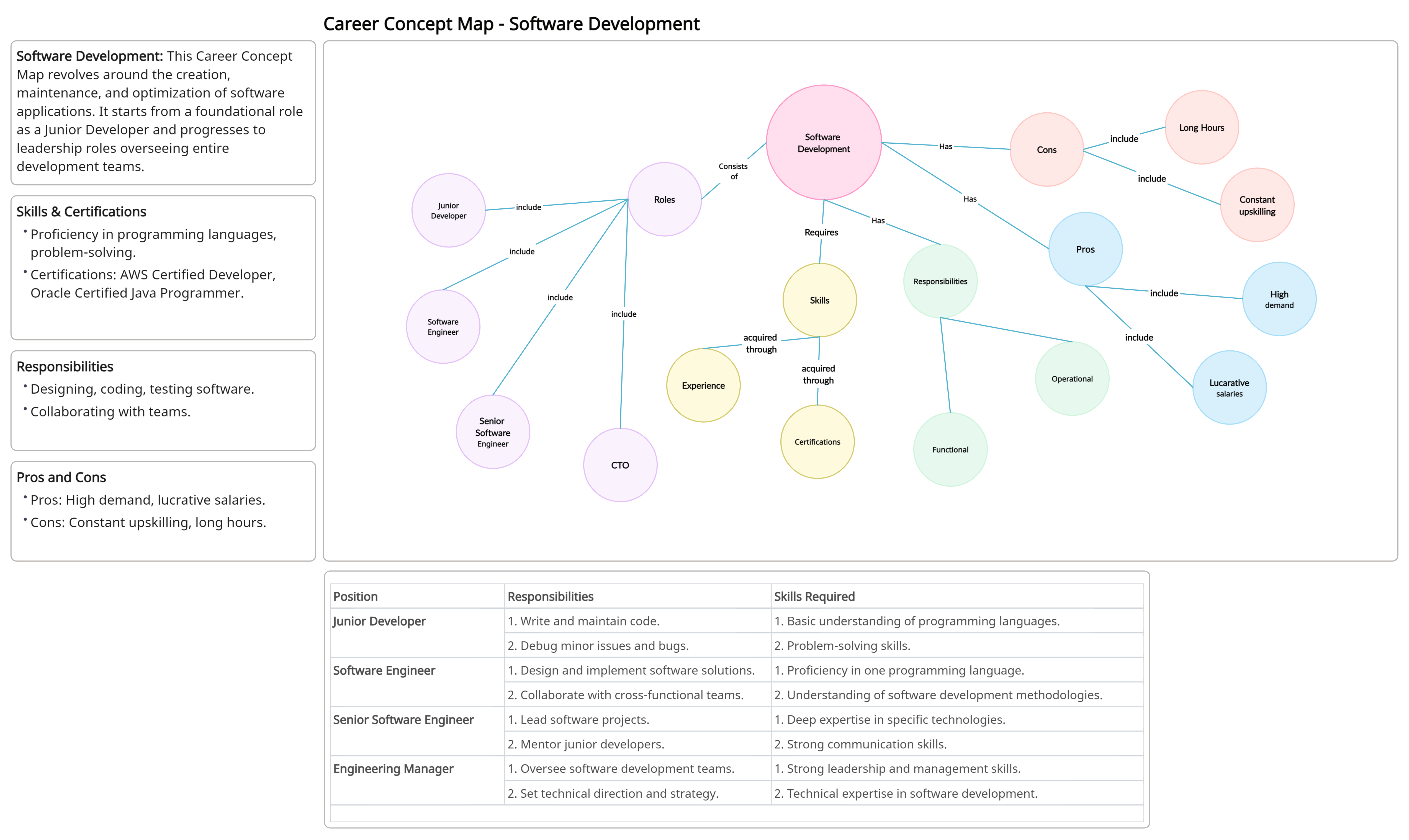
- Ready to use
- Fully customizable template
- Get Started in seconds

Marketing: For those passionate about market dynamics, this template offers a path from assisting in campaigns to strategizing and leading marketing drives.
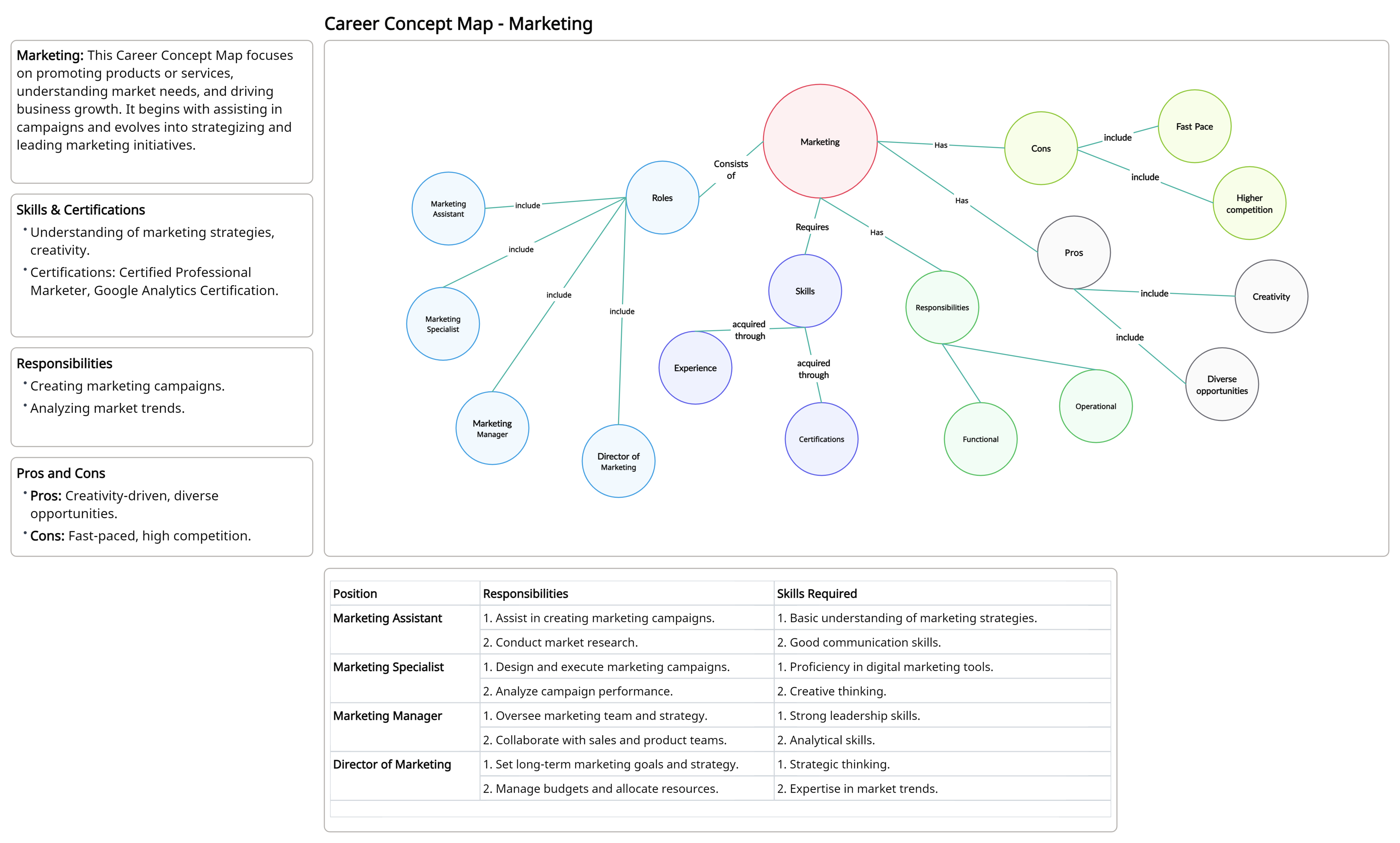
Finance: Tailored for finance enthusiasts, it charts a journey from basic financial tasks to high-level fiscal decision-making roles.

Human Resources (HR): This map is for those who thrive in people management, guiding them from recruitment roles to strategic HR planning positions.
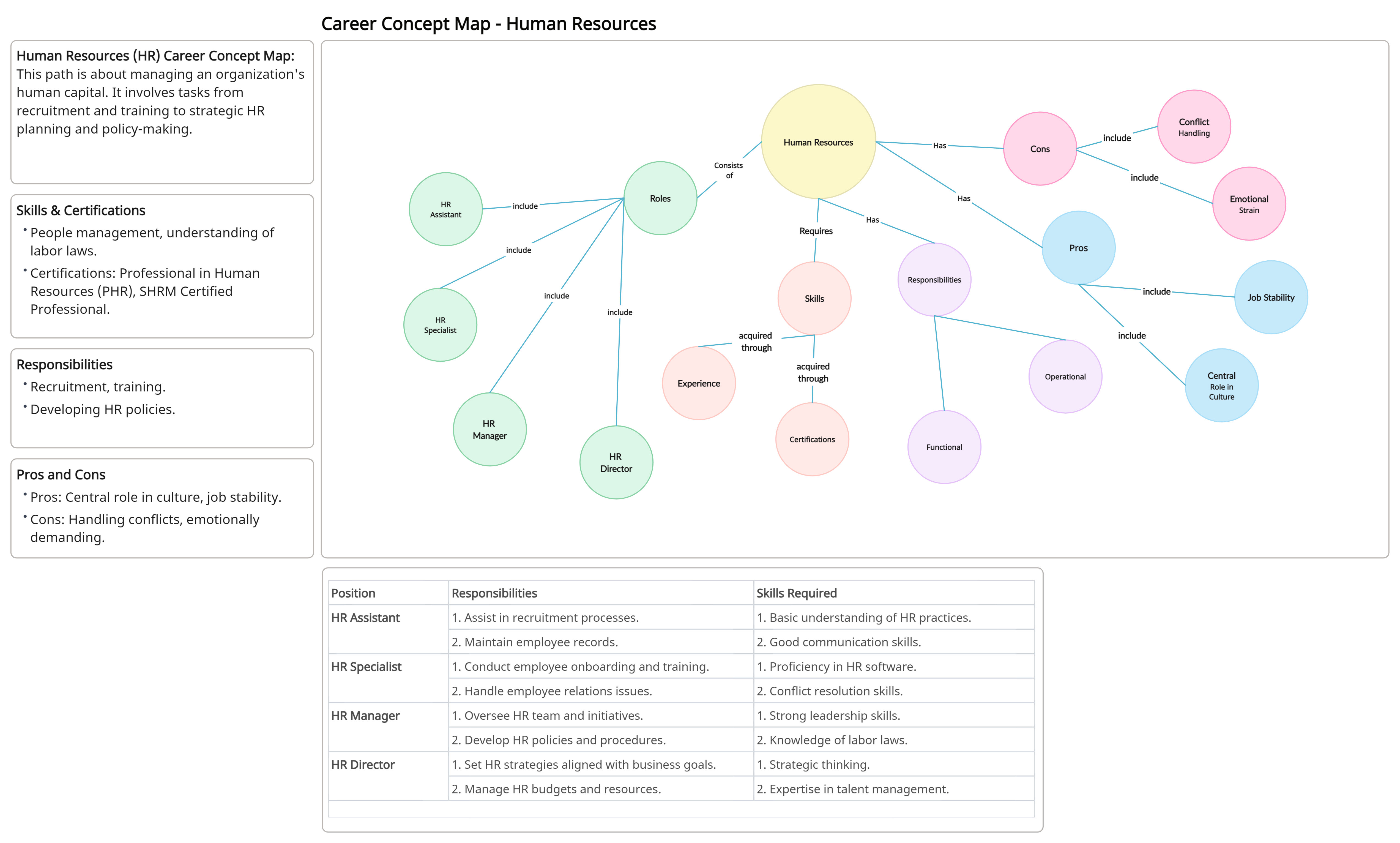
Sales: A trajectory for the go-getters, it spans from direct sales roles to leadership positions overseeing sales teams.
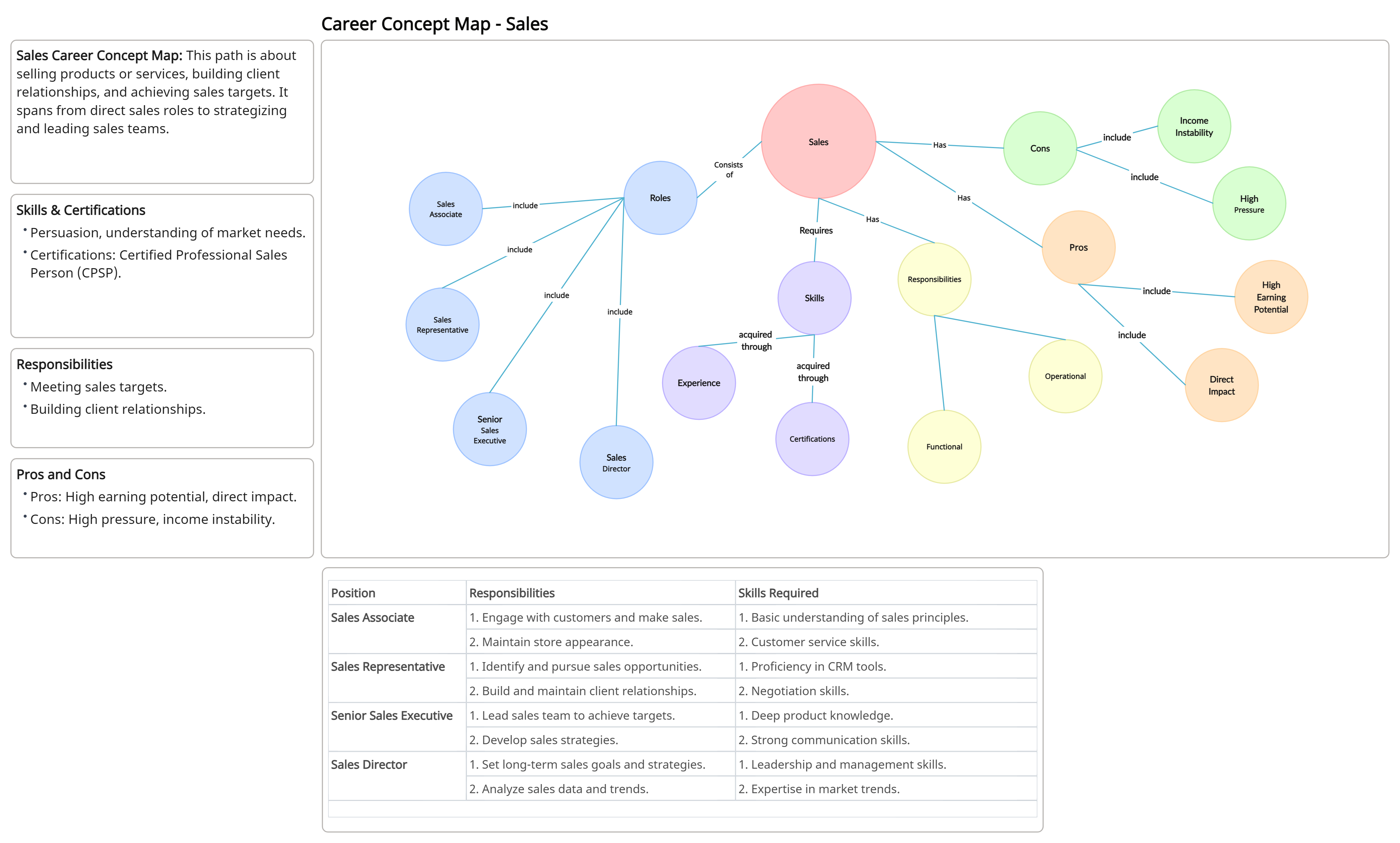
Design: Creatives can find their path from assisting in design projects to leading design teams and setting design directions.

Healthcare (Nursing): Dedicated to the noble profession of healthcare, this map guides from basic nursing roles to leadership positions in nursing departments.
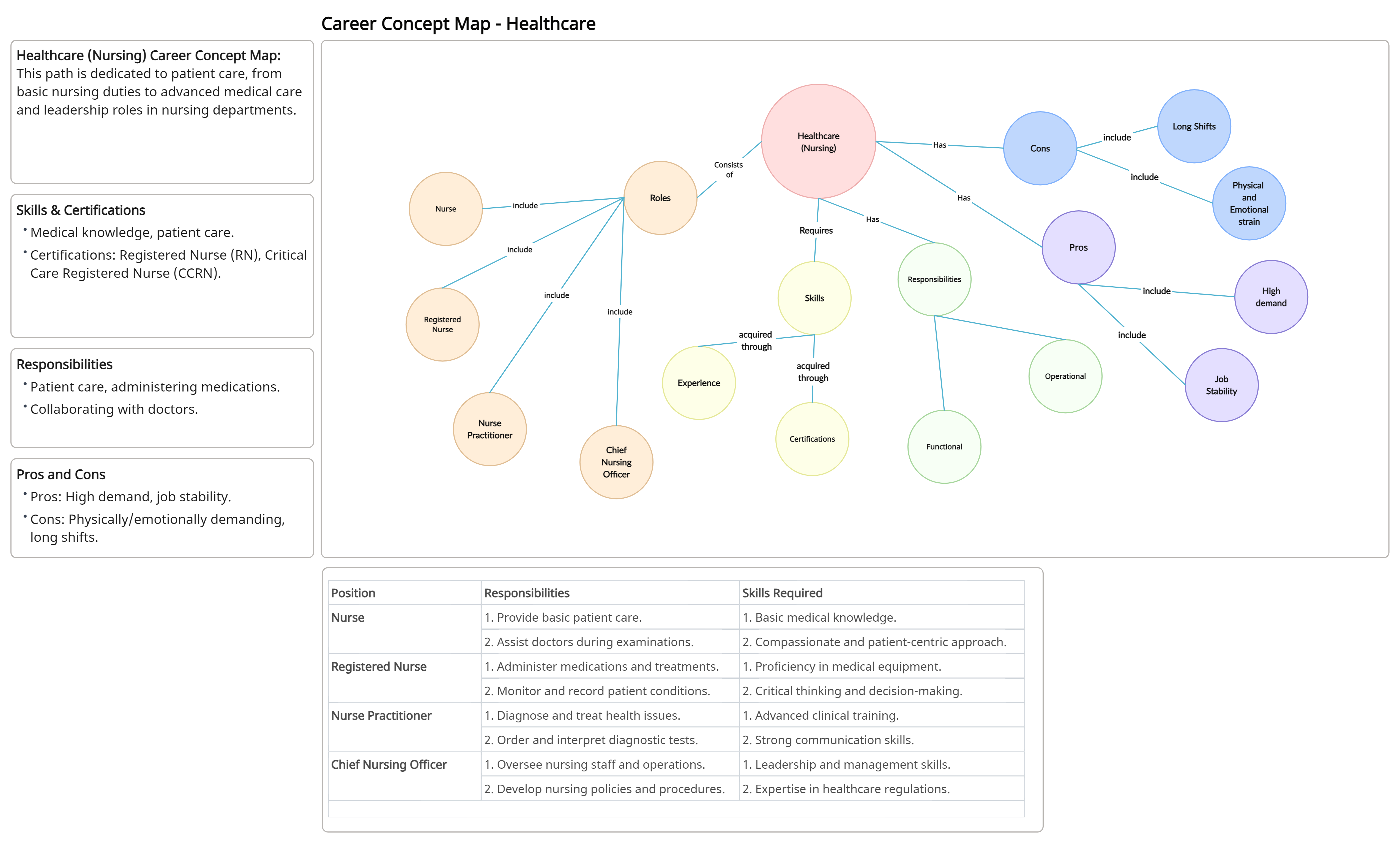
Education: Educators can chart their journey from classroom assistance roles to leading educational institutions.
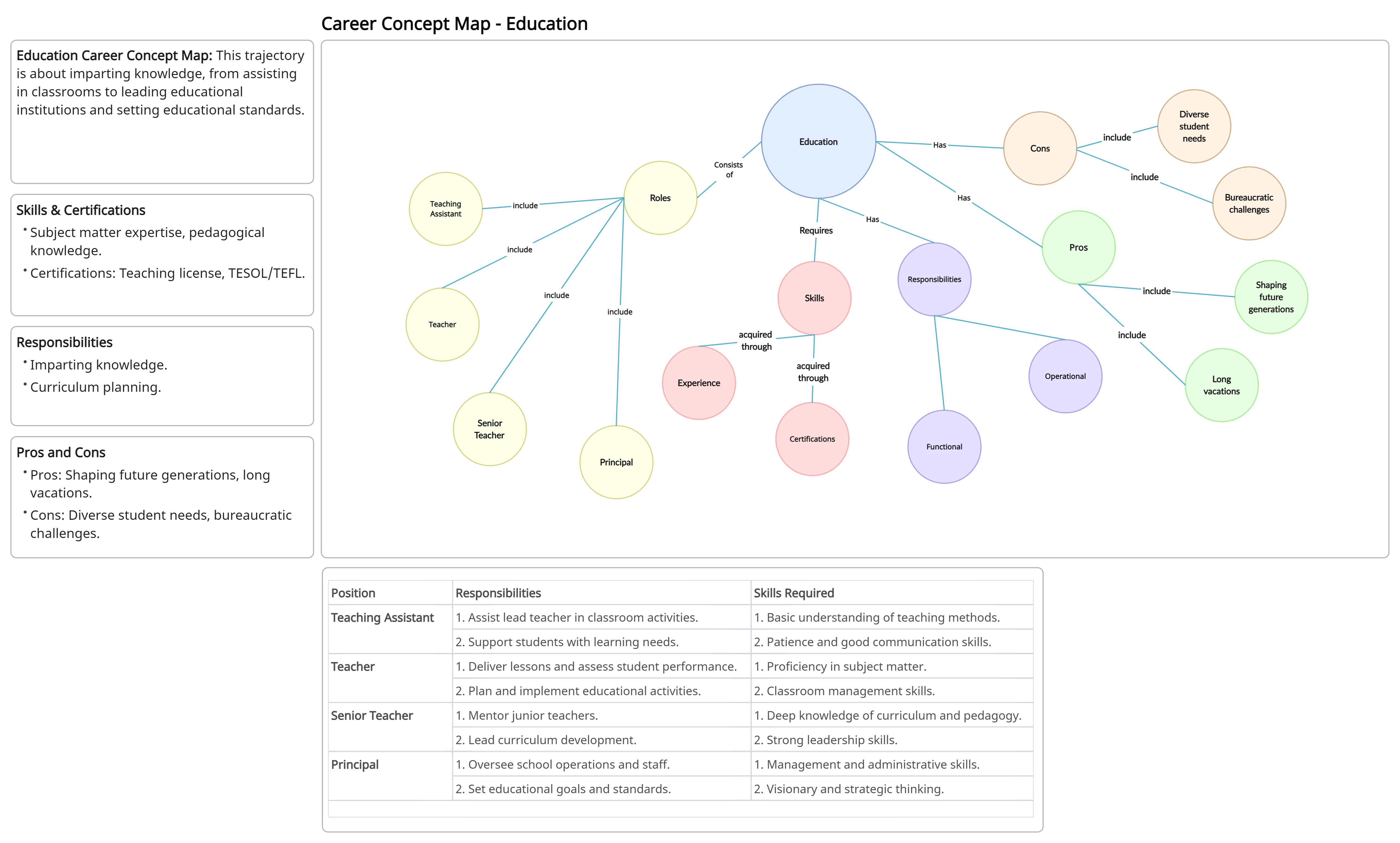
Research & Development: Innovators can navigate from assisting in research projects to leading entire research departments.
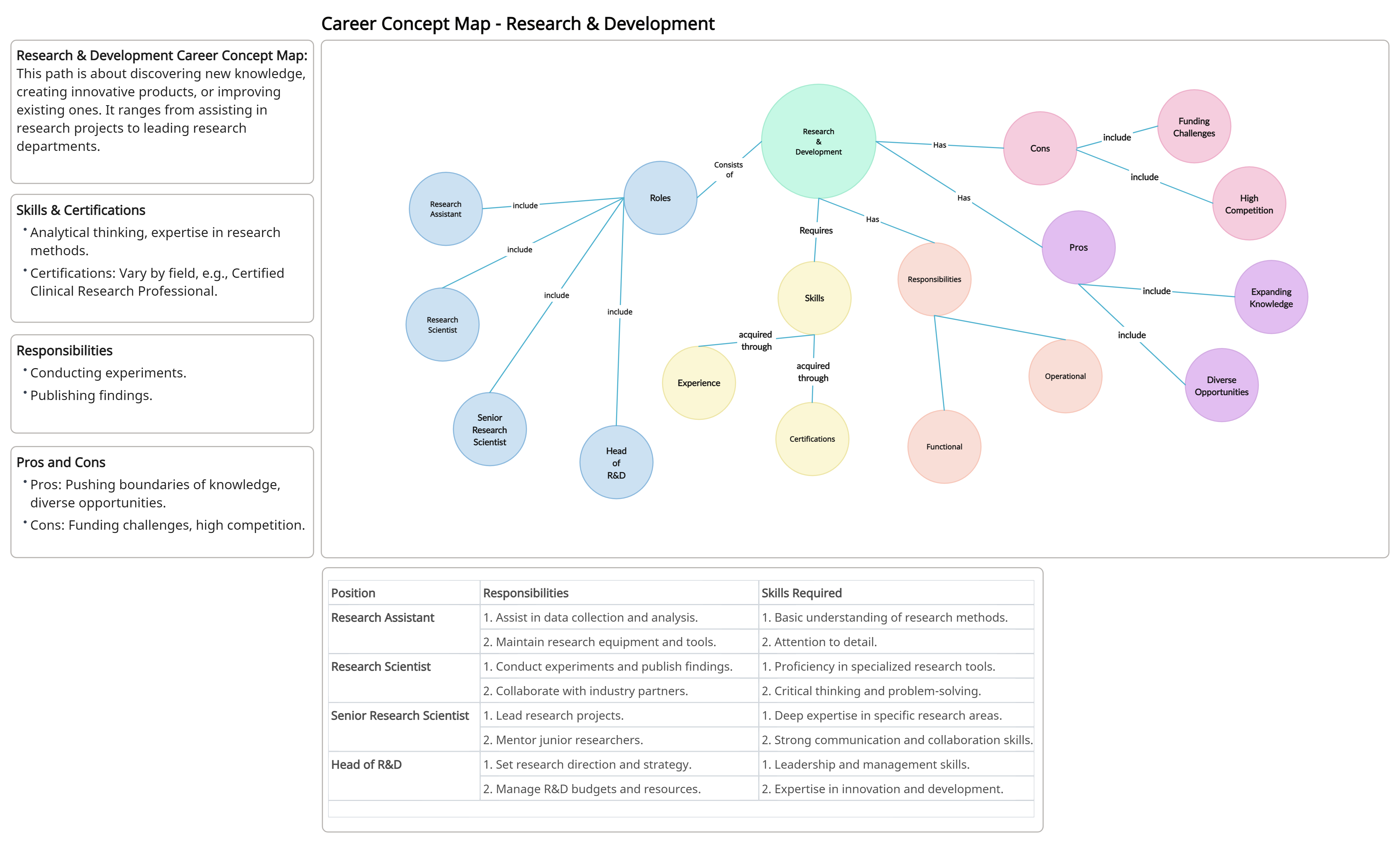
Operations: This map is for those who ensure businesses run like well-oiled machines, guiding from operational tasks to overseeing entire operations.

In Conclusion
The templates provided above aren’t just tools; they’re foundational blueprints designed to guide your professional journey. As you harness the power of the Career Concept Map Maker , envision a journey where every decision aligns seamlessly with your aspirations. Let this tool be the compass that ensures each step you take is both strategic and in tune with your career goals.
Join over thousands of organizations that use Creately to brainstorm, plan, analyze, and execute their projects successfully.
More Related Articles

Hansani has a background in journalism and marketing communications. She loves reading and writing about tech innovations. She enjoys writing poetry, travelling and photography.
Filter by Keywords
10 Career Map Templates to Empower Your Team’s Growth Path
Senior Content Marketing Manager
February 13, 2024
Managers play a crucial role in helping their employees achieve their career goals. 🏆
Career map templates are a powerful tool to help managers and their team members identify career growth opportunities and support them with a roadmap to hit key milestones.
In today’s fast-paced and competitive job market, employees must constantly develop new skills and knowledge to advance their careers. For new hires, it’s essential to personalize the onboarding experience to provide a clear picture of how to be successful in their roles.
Career roadmap templates also help organizations retain talent by providing opportunities for employees to achieve their full potential. Supporting employee growth shows your team that leadership is invested in their future and wants them to grow with the company.
Learn what are career map templates, what makes a good template, and 10 of the best career roadmap templates you can use to pave your team’s growth path.
What Are Career Map Templates?
What makes a good career map template, 1. clickup career path template, 2. clickup employee development plan template, 3. clickup personal development plan template, 4. clickup performance report template, 5. clickup performance review template, 6. clickup 30-60-90 day plan template, 7. clickup bonus matrix template, 8. clickup roadmap whiteboard template, 9. clickup smart goal action plan template, 10. clickup milestone chart template, grow your dream team with clickup.
Career map templates are visual, motivational tools that help employees and their managers identify career goals , assess current skills and competencies, and outline a plan of action to achieve those goals.
They can include sections for setting SMART goals , identifying training and development opportunities , productivity metrics , and tracking progress over time. Career roadmap templates can be customized to suit each individual’s specific needs and career goals.
A good career map template should be easy to use and understand. It should break down measurable career objectives, assess a current or particular skill, and competencies, and outline action items and work habits to achieve those goals.
To ensure your career map is effective, it should be easily accessible and integrated into existing workflows. It’s helpful to link each employee’s career map to their individual 1-on-1 agendas, relevant tasks, or performance reviews to keep the plan in mind and facilitate regular check-ins.
In the event an employee’s priorities change, the career map should allow for customization to suit each employee’s role or department-specific needs and career goals. Employee career maps should be regularly updated to reflect changes to career goals and showcase progress made over time.
How do career maps motivate employees?
Career maps provide employees with a sense of direction and purpose in their work. When employees have a clear sense of expectations and what success looks like, they are less likely to feel stuck in their current roles, which can lead to disengagement and a lack of motivation.
Managers can also use career maps to promote a culture of transparency and fairness. When employees understand the criteria for promotion and advancement, they are more likely to believe that their employers are making decisions based on merit. This can lead to increased trust in the organization and a greater sense of loyalty among employees.
10 Career Map Templates
Building a productive, successful team starts with the right tools to promote long-term growth and professional development. Use the following career roadmap templates to support employees throughout their career paths.

Need to quickly set up an employee with clearly defined career goals? Use the ClickUp Career Path Template to create a detailed career plan to track personal career aspirations and organizational objectives to promote growth opportunities.
Add sections for identifying key skills and competencies, action plans for each goal, and target metrics to focus on. You can also use this template to track progress in one place for a solid career roadmap.
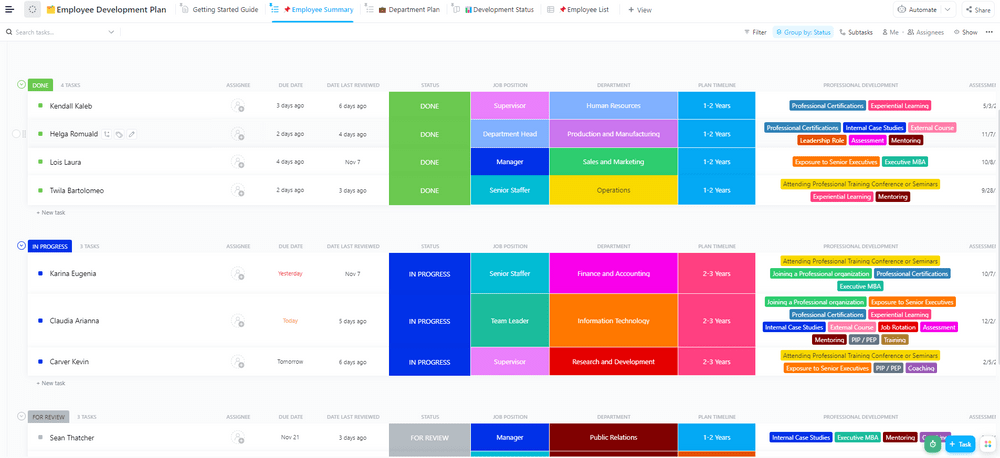
Every employee brings their own unique set of strengths and knowledge to a team or department. Follow the ClickUp Employee Development Plan Template to create a development plan to improve employee skills and competencies.
This template includes sections for identifying areas for development, setting goals, and creating action plans to achieve those goals.

Helping your team members to take ownership of their personal development and career plan has numerous benefits for both the employee and the organization. When employees are empowered to identify their own development areas and create actionable plans to address them, they are more likely to be engaged and motivated in their work.
The ClickUp Personal Development Plan Template helps employees create a career roadmap for personal growth and development. The template includes sections for setting personal goals, identifying strengths and weaknesses, and creating action plans to achieve those career ladder goals.

Without proper documentation, it’s easy to fall into the trap of recency bias. This is a cognitive bias that favors recent events over historic ones, which often happens when there aren’t facts or metrics to reference when performance reviews roll around.
The ClickUp Performance Report Template is designed to help managers accurately assess employee performance for the best career plan. The template includes sections for tracking progress toward goals, identifying areas for improvement, and creating action plans to address performance gaps.
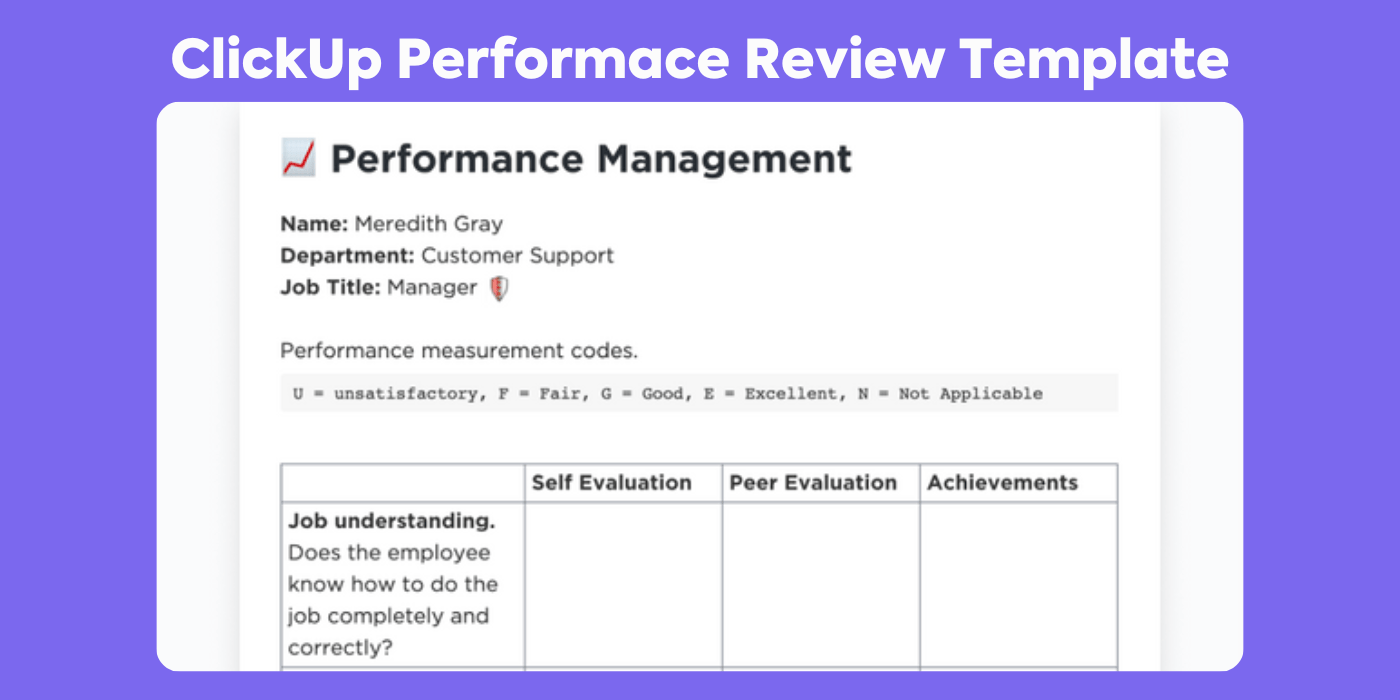
The ClickUp Performance Review Template is a customizable template that helps managers and employees prepare for performance reviews. The template includes sections for assessing performance, identifying areas for improvement, and creating action plans to address performance gaps.
With this template, employees can come prepared for performance reviews with concrete examples of their accomplishments and areas of opportunity. The template can also help managers facilitate productive conversations with their employees and provide actionable feedback on areas for improvement.
By using this template, managers can create a more transparent and collaborative environment that promotes accountability, growth, and development!

Successful onboarding starts with preparation. The ClickUp 30-60-90 Day Plan Template is designed to help new hires create a roadmap for success in their first 90 days on the job .
The template includes sections for setting goals, identifying training and development opportunities, and creating action plans to achieve those goals.
With this resource, managers can provide new hires with a clear understanding of their job responsibilities, organizational objectives, and expectations.

Who doesn’t love an incentive program? Showcase the perks offered to employees for hitting specific milestones to provide an extra push!
The ClickUp Bonus Matrix Template is a customizable template that helps managers calculate employee bonuses based on performance. The template includes sections for setting performance criteria, calculating bonus amounts, and tracking bonus payments.

The ClickUp Roadmap Whiteboard Template is a universal planning template that helps teams create a visual roadmap for scoping projects . The career plan template includes sections for setting project goals, identifying key milestones , and creating action plans to achieve those goals within their career roadmaps.
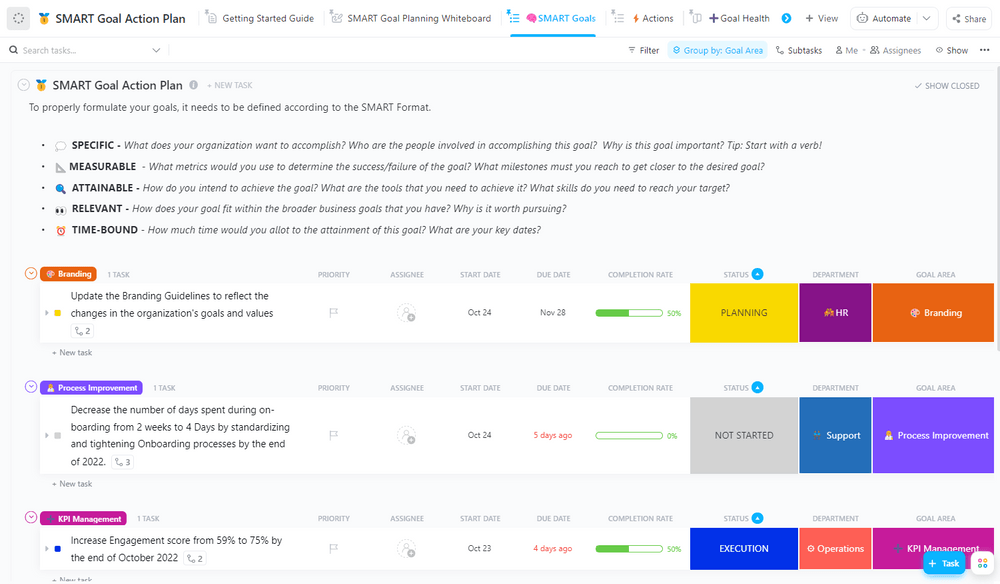
The ClickUp SMART Goal Action Plan Template is a customizable template that helps individuals and teams set SMART goals and create action plans to achieve those goals. Of the career roadmaps templates, this one includes sections for setting specific, measurable, achievable, relevant, and time-bound goals.

The ClickUp Milestone Chart Template is a customizable template that helps teams visualize project milestones and deadlines. The template includes sections for identifying key milestones, setting deadlines, and tracking progress toward those milestones.
Empower your employees to take ownership of their career roadmap growth and development and set clear expectations and standardized processes for them at the same time! When you create an environment where employees can devote time and focus to their career goals, you identify areas for development and build better roadmaps to achieve their goals.
Simplify employee career roadmap growth plans for both managers and employees with our quick, easy-to-follow templates. Now that you have the resources to guide your team through their professional goals, you can start building individual career maps in ClickUp for each of your direct reports.
Access even more career growth templates, plus 100MB of storage, unlimited tasks and members, over 1,000 integrations, collaborative Docs, and so much more for free, forever in ClickUp ! 🦄
Questions? Comments? Visit our Help Center for support.
Receive the latest WriteClick Newsletter updates.
Thanks for subscribing to our blog!
Please enter a valid email
- Free training & 24-hour support
- Serious about security & privacy
- 99.99% uptime the last 12 months
- Talent Seekers
- PARTNERS Employers Data & Insights Colleges Workforce Demo

How to Map Out Your Career Path – With Examples
- A career path is essentially a roadmap for your personal and professional development.
- Career paths don’t always follow a straight line.
- Your career path is not set in stone. You can change it at any point based on your needs and experiences.
It always comes out of nowhere. You’re doing something innocent—like getting coffee or walking the dog—and the unwanted thought suddenly pops into your head: Where the duck is my career going?
Totally weird that your brain has autocorrect…
Odd brain quirks aside, this particular thought isn’t an uncommon one to have, especially if you’re newly graduated, or you’ve been working the same dead-end job for the last few years. When your career seems to come to a complete standstill, it can be difficult to know what your next step should be.
Does this sound depressingly familiar? If so, it’s time to seriously consider mapping out your career path.
GET STARTED USING TALLO
What Is a Career Path?
We all want to score a good-paying job in an industry that we love. But let’s face it, life isn’t some feel-good movie, and amazing career opportunities rarely just fall into people’s laps.

To achieve the career you want, you need to be strategic with the jobs you take. That’s where mapping out your career path can be a major help. Your career path is simply a series of jobs you take that ultimately lead you to your dream career. Career paths go hand-in-hand with a career plan , which is basically a list of short- and long-term goals that you strive for along your career path.
By mapping out a career path, you can…
- Avoid taking jobs that get you nowhere. Chances are good that you’ll have at least a few job changes over the course of your career. When you’re tempted to leave your current job for greener pastures, it helps to ask yourself one simple question: Will this progress my career in the direction that I want? If the answer is no, think twice before you jump ship.
- Identify gaps in knowledge and skills. Not sure what skills or training you need to progress to the next step in your career? Mapping your career path takes a lot of the guesswork out of the equation by helping you see which skills you need to reach your future career goals.
- Strive for something other than a paycheck. Sure, you want a job that pays the big bucks. Who doesn’t? But for many employees, a paycheck isn’t enough to keep them motivated at work. They want to be fulfilled in their careers, and that comes through personal and professional development.
- Bounce back quicker from career setbacks. Mapping out your career won’t make you immune to career setbacks. However, it can help you get back on track if your original career plans are derailed. Getting laid off unexpectedly can be super scary, but with a career strategy in place, you can pick up the pieces quickly and come back stronger than before.
Career Paths Are Not Set in Stone
If the idea of charting a career path for yourself makes you nervous, we totally get it. A lot of people feel like their future is set in stone once they make an official roadmap for it. Who knows what the future has in store, right?
But here’s the thing: Career paths can and do change, usually in our formative years. In fact, about one-third of students decide to change their major within three years of declaring it.
For others, the decision to change careers comes much later in life. This can lead to an interesting career path that resembles a winding road, which is completely normal. As you’ll see below, not all paths need to follow a straight line.
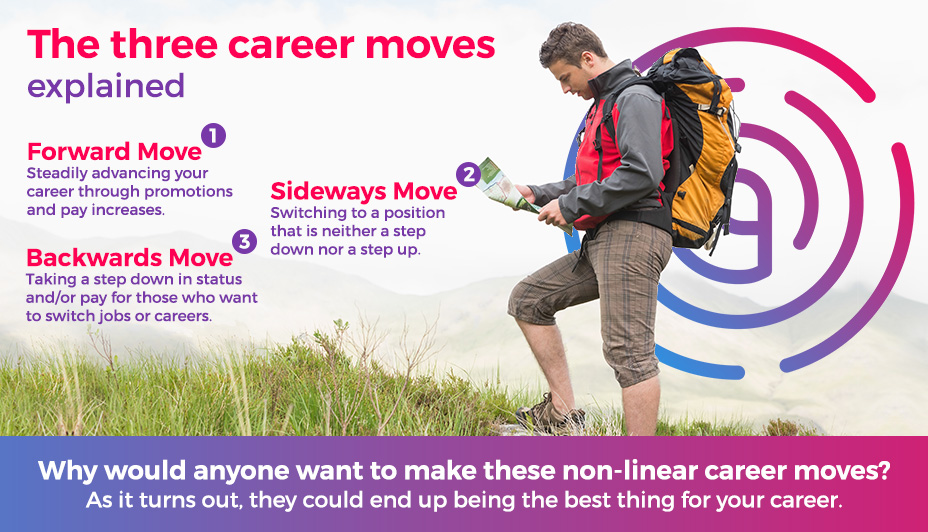
Make Your Move: 3 Powerful Career Moves You Should Know
Most of us want to move up in our careers. This is why organizations use phrases like “climbing the career ladder” and “vertical career mobility” to describe career advancement.
But did you know that working your way “up” isn’t the only direction your career path can go? You can also move sideways (aka, the “lateral” career move) and even backward.
Why would anyone want to make these non-linear career moves ? As it turns out, they could end up being the best thing for your career. Here are the three career moves explained:
- Forward Career Move: The forward career move is what most people strive for in their careers. This move involves steadily advancing your career through promotions and pay increases. Example: Getting promoted from sales leader to vice president of sales.
- Sideways Career Move: This sideways or lateral career move can be a total game-changer for your career. This move involves switching to a position within your company that is neither a step down nor a step up. Employees may choose to move laterally in their careers in order to broaden their experience and become more successful in future positions. Example: Transitioning from the finance department to the sales department within the same company.
- Backward Career Move: A backward career move involves taking a step down in status and/or pay. While this might seem like career suicide, it makes perfect sense for those who want to switch careers or those who have been pigeonholed in their jobs. Who knows? If the perfect job opportunity comes your way, it could be worth it to start from scratch. Example: Leaving a job as an accountant to pursue a career opportunity as an editorial assistant.

Career Path Examples
You know that mapping your career path can be beneficial in the long term. You also know that you can move in several different directions to achieve your dream job. Now, let’s see this in action with a few career path examples.
Example #1: Education
Dream Job: Principal
Starting Point: Bachelor’s Degree in Teaching
- Milestone 1. Become certified as a teacher
- Milestone 2. Work for 3+ years while attending conferences and training seminars
- Milestone 3. Earn a master’s degree in teaching
- Milestone 4. Get promoted to assistant principal
- Milestone 5. Work for a few years before getting promoted to principal
Example #2: Technology
Dream Job: Software Development Manager
Starting Point: Finance Manager
- Milestone 1. Enroll in a coding bootcamp while working as a finance manager
- Milestone 2. Leave the current job to pursue a career in software development
- Milestone 3. Get a job as a junior software developer
- Milestone 4. Work for a few years before getting promoted to senior software developer
- Milestone 5. Get promoted to software development manager
Example #3: Entrepreneur
Dream Job: Business Owner
Starting Point: Salesperson
- Milestone 1. Start entry-level sales job
- Milestone 2. Get promoted to sales manager
- Milestone 3. Move sideways to take a position in the marketing department
- Milestone 4. Get promoted to senior marketing manager
- Milestone 5. Earn MA degree in marketing
- Milestone 6. Get promoted to vice president of marketing
- Milestone 7 . Leave company to start your own marketing business
Example #4: Electrician
Dream Job: Master Electrician
Starting Point: High School Graduate
- Milestone 1. Enroll in technical college
- Milestone 2. Score an electrician apprenticeship and work for 4+ years
- Milestone 3. Apply for a journeyman electrician license
- Milestone 4. Gain experience as a journeyman electrician
- Milestone 5. Apply for a master electrician license
Example #5: Lawyer
Dream Job: Partner at a Law Firm
Starting Point: Bachelor’s Degree
- Milestone 1. Graduate from law school
- Milestone 2. Pass the bar exam
- Milestone 3. Work as a law associate at a firm
- Milestone 4. Work for six to nine years before making partner
How to Map Your Career Path from Scratch
Ready to take a stab at mapping your own career path? Here’s how to create an effective career path process that will put you on the fast track to success.

Step 1: Create a Detailed Career Map
The first step to mapping out your career is to create a career roadmap for yourself. Like the examples above, you should start from the top down with your dream job. Make a list of the sequential positions you’ll need to get there, keeping in mind that opportunities may arise where you can move sideways to expand your expertise.
Step 2. Fill in Position Profiles
After you’ve mapped out the job positions you need to reach your dream job, fill out the necessary skills, experience, training, and certifications you’ll need to achieve each step in your career. If you’re in a competitive field, you may want to consider listing a few additional skills that may increase your chances of advancing quickly.
For example, let’s say that you’re filling in a position profile for an assistant director of human resources. This is what it might look like:
Assistant Director of Human Resources
Minimum Qualifications:
- Bachelor’s degree in human resources, business, or a related field
- Three to five years of experience in human resources positions
- Proficiency with digital record-keeping and computerized communication
- Excellent analytical and interpersonal skills
- Strong leadership qualities
Desirable Qualifications:
- Master’s degree in Human Resources
- Experience with human resource information system (HRIS)
- SHRM certification
Step 3. Do Your Research
Once you have a career map, start doing in-depth research for different positions, with a heavy focus on your dream career. Carve out time each day to read news related to your industry and read blogs written by those in your field. To get a clearer picture of your dream job, try finding a job shadowing opportunity that will give you a behind-the-scenes look at your future career.
Step 4. Expand Your Knowledge and Skills
Now comes the tricky part: gaining the skills and knowledge you need to progress in your career. Read books, take online courses, and use whatever resources you have available to you at work to expand your skillset. Don’t forget to ask for performance reviews at work to see if there is anything that could stand to be improved.
If you want to speed the process up considerably, look into getting a mentor. A good mentor can be a huge asset to your career by teaching you valuable skills and being a source of support.
Step 5. Set Small Goals for Yourself
While big career goals may be admirable, they can be unrealistic or difficult to achieve. To keep yourself motivated and on track, be sure to set small, attainable goals that keep you moving toward your big goal. For instance, maybe your smaller goal is to learn Ruby programming in three months to help you reach your big goal of becoming a developer for a tech startup. Once you reach your milestone, continue setting small goals while keeping the bigger picture in mind.
Step 6. Network to Gain Visibility
Never stop networking! It’s seriously one of the single best things you can do for your career. Not only can networking broaden your job opportunities outside of your company, it can help you make a powerful lateral move to a different department. By networking with people outside of your department, you can learn about different positions within the company and get first-hand knowledge of what those positions entail. And if you make a good impression, you could give yourself a big advantage if/when you decide to apply for the position.

Preparing for a Brighter Future
You wouldn’t take a road trip without knowing where you were going, right? Mapping out your career path is like using your phone’s GPS for a trip. It tells you where you need to go in order to reach your final destination. Remember, it’s not set in stone! Be flexible with your career path and good things are sure to come your way.
RELATED POSTS

Let’s Go 2024: Set New Year’s Resolutions for Your Biggest Career Goals

10 Key Skills You Need for the Future Workplace

How to Make the Most of College and Career Fairs
Start charting your path today..
Connect with real educational and career-related opportunities.
Get Started

What Is a Career Map?
Why create a career map, how to make a career map, final thoughts, career map: definition, template and example.
Updated October 27, 2023

All products and services featured are independently selected by WikiJob. When you register or purchase through links on this page, we may earn a commission.
A career map or a career mapping are a detailed written plan setting out where you are right now in your career, where you would like to end up and the specific steps you need to take to reach your ultimate objective.
Employers may create career maps for or with their employees, explaining how individuals can advance through the organization and the requirements they need to fulfill at each stage.
Your own career map, however, will be very personal to you and is a document you create for yourself. It may involve determining a route for progression within your current organization, or you may be aiming for a position with a rival firm, to start your own business or even to move into another industry.
While you may have a vague idea of your career goal in your head, if you haven’t pinned this down and made a clear plan of how you are going to get there, you are leaving a lot to chance.
Creating a career map will give you more control over ensuring that you make the right moves and decisions in your career to reach your chosen destination. It also provides an opportunity to examine the skills and strengths you already have and any weaknesses or gaps in your knowledge you may need to address.
The format of a career mapping encourages you to think about both short-term goals and long-term goals , and to define the steps you will need to take to move towards your final goal.
Spending some time thinking about all these different aspects will give you a much better insight into the career path you wish to follow and how to succeed.
By writing your career development plan down, you will have a document to refer back to, so you can make sure you stay on track while recognizing and celebrating the progress you have made as you achieve each step.
Step 1 . Identify Your Starting Point
The first step in creating your career map is to carry out an in-depth evaluation of where you are right now.
Spend some time considering your strengths , skills and passions as well as your weaknesses , skill gaps and anything else that may hold you back.
Think about where you excel and what excites you in your current job and what you dislike or struggle with.
Be very honest with yourself and write everything down. This detailed review of yourself and your current situation will help you develop a better idea of what your long-term goal is and how to get there.
Step 2 . Define Your Ultimate Goal
Again, you need to be detailed and specific when determining where you want your career map to take you.
If your objective is to move into a particular position, identify what this means in terms of the job description and person specification.
You might be able to find this information through your own employer or via the careers websites of companies you would like to work for, or you may need to interview people in similar roles to find out exactly what they do (our article on informational interviews will help with this).
Whatever your goal is, make sure it is measurable, so you will know when you have reached it.
Step 3 . Set Your Short and Longer-Term Goals
Once you know where you are right now and where you want to end up, it should be much easier to establish the skills, experience and competencies you already have, and those you still need to acquire to reach your goal. You can then break this down into a series of steps.
Setting yourself smaller goals that you can tick off as you go will make your ultimate objective seem much less overwhelming and help you feel as though you are making progress.
Be very clear about what each of your short-term goals entails. They could include gaining specific qualifications or experience, or taking on interim positions you may need to hold before being considered for your dream job. Don’t aim too low, but keep these goals realistic and set yourself deadlines for completing them.
When you have achieved one of your smaller goals, don’t forget to acknowledge and celebrate your achievement. Recognizing the progress you have already made will help you to keep your end goal in sight and stay motivated.
See our articles on achievable career goals and career strategies for more advice on setting goals.
Step 4 . Ask for Input
If your goal involves progressing in your current company, letting your manager know about your ambitions can help to clarify your career map. You may want to discuss whether your plan fits with how they see you moving up in the company.
They might also be aware of paths for promotion or development that you weren’t aware of and can assist you by directing you towards training programs or by looking for opportunities to assign you projects that will move you closer to your goal.
Alternatively, consider finding a mentor outside of your company who can give you insight into the career you are aiming for, along with ongoing feedback and support as you work through your career map.

Step 5 . Include Lifestyle Goals
While your career map will be focused on your professional life, it is important to also consider your personal ambitions and objectives and to think about how these could impact your goal.
For example, if you want to live abroad, work remotely or start a family, this might affect decisions you make in your career, so be sure to take these into account when creating your map.
Step 6 . Keep Checking In
Once you have created your career map, make sure you keep coming back to it to see how you are doing.
If you have created a physical career map with pen and paper, put it up somewhere you will see it every day.
If it’s in digital format, set yourself regular reminders to look at it and evaluate your progress.
Step 7 . Be Flexible
While you want your career map to be detailed and specific, you should also be prepared to adapt your plan as needed.
External events may require you to reconsider some of your goals, industries will evolve and your own priorities could change, so keep an open mind and don’t be afraid to alter or update your career map.

Career Map Template for Your Job Map
The career map you create will be unique to you and the industry you work in, and the format you follow will reflect this.
Below we have provided a template that may serve as a useful starting point to begin thinking about your own career map.
For this sample career map, we have imagined someone who is currently working as a camp counselor, whose ultimate goal is to become an elementary school principal.
Career Map Example for Starting Point
Outline where you are now, giving full details of your current job description , skills and experience.
For example:
Current Job Summer camp counselor, working with children aged 8–14, including: Leading a cabin group Coordinating my cabin group’s daily schedule Creating and leading camp activities Assisting with camp activities Monitoring mealtimes Mediating in any conflicts that arise Delegating chores where needed Key Skills and Attributes Good with children Passionate about working in education Strong leader Good at multi-tasking Fun-loving and enthusiastic Determined Able to work under my own initiative Good at resolving conflict Weaknesses and Skill Gaps No teaching qualifications No experience of teaching in a school Limited experience of working with younger children Limited experience of leading peers
Career Map Example for Short-Term Goals and Objectives
Once you have established where you are now and created a detailed definition of your end point, work out what steps you will need to take to get from A to B.
Remember to make these specific and to set a timescale for completing each one.
1. Secure work placement in a school, ideally working with children under eight years old to gain experience with younger children. (By end of current year) 2. Obtain undergraduate bachelor’s degree in elementary education. Complete all necessary state licensing and certification. (Four years from beginning of course) 3. Secure job as an elementary school teacher while working towards master’s degree in education leadership. Take advantage of all professional development and training opportunities available, as well as any opportunities to take on leadership responsibilities. (Two years) 4. Move up to working as vice principal, taking on more responsibility and gaining further experience in areas such as planning for school improvements, handling student discipline and concerns from parents, training and observing staff. (Two years)
Career Map Example for End Point
Give full details of the role you are ultimately aiming for, including job description and person specification.
Final Goal – Elementary school principal: Leading a school’s administrative team and taking responsibility for overseeing daily operations Coordinating staff training and development Working directly with children, helping them to achieve their goals Liaising with the school board and ensuring that the school adheres to its board’s protocols Developing programs to improve school performance Creating benchmarks to track progress Upholding educational policies and responding to concerns from parents, teachers or students Person Specification Must be a licensed and experienced teacher High standards and expectations The ability to motivate, inspire and lead Excellent communication and interpersonal skills Highly organized Evidence of contributing to raising standards in a school setting Thorough understanding of curriculum development, classroom management and national educational policy An innovative and creative approach
Career Mapping Tool
One effective approach to strategically plan your map of work involves utilizing a powerful career mapping tool.
This invaluable resource empowers both individuals and human resources teams to gain a comprehensive perspective on an employee's current position and the necessary steps to advance to the next level.
When employing a career mapping tool, several essential factors come into play.
These encompass self-assessment, alignment with organizational objectives, personal development targets, and the identification of roles that align most harmoniously with one's aspirations.
Furthermore, a dynamic career progression framework becomes instrumental in showcasing development opportunities and potential openings, all of which can be seamlessly integrated using real-time data.
This framework incorporates versatile career ladders and lattices to illustrate one's progression and mobility throughout their professional journey.
To remain consistently attuned to your professional aspirations, it's crucial to have a dedicated document or software solution that not only charts your career map but also serves as a timely reminder of your current position, pending objectives, and their respective timelines.
Regardless of your chosen profession, the ability to set and align goals with your passions and interests hinges on thorough research into roles that align with your ideal career.
This entails creating a comprehensive list of positions and the requisite knowledge you must acquire to facilitate your progress.
A career mapping tool proves invaluable in visualizing potential forward, lateral, and backward career moves, offering a holistic view of your professional trajectory.
Career Mapping for Employees
What does Career Mapping for Employees entail?
Initially, it requires active involvement from the HR department in constructing a comprehensive career progression framework.
Utilizing a career map tool in various ways, finding the one that aligns best with an employee's preferences can significantly impact their engagement with the career progression plan.
Employees might not fully grasp the intricacies of the career mapping process.
This is where the HR team plays a pivotal role in elucidating the advantages of career mapping, solidifying the company's commitment to fostering a culture where employees are not only valued but also nurtured and prepared for advancement within the organization.
Here are several benefits that employees should be well-informed about:
Enhanced Self-awareness: Career mapping facilitates a deeper understanding of one's skills and abilities, preventing unrealistic career aspirations like aspiring to become a CEO without comprehending the considerable effort required to reach that pinnacle.
Expanded Knowledge: Career mapping brings attention to new roles, offering employees clarity about their existing skills and the competencies they need to acquire.
Self-development Opportunities: Engaging in career mapping necessitates introspection and a willingness to confront personal truths. Some employees may discover early on that they are not inclined to invest the extra effort required for advancement. Achieving career goals demands discipline, focus, and the cultivation of qualities conducive to upward mobility.
Effective Assessment: Career mapping assists employees in recognizing when they are content in their current roles and when they are ready to embrace new challenges and seek greater responsibilities.
Increased Visibility: Engaging in career mapping enhances an employee's visibility within the organization, providing more opportunities to interact with individuals who hold the keys to growth and promotion.
Whether you are just starting out in your career or are already some years into your chosen profession, you should always have a clear idea of where you are heading and why. Without defined goals and a strategy for progression, you are at risk of drifting off course and not making the most of opportunities as they arise.
A career map provides you with the framework to make a thorough analysis of what you want out of your career while creating a detailed plan that will keep you moving towards your desired destination.
You might also be interested in these other Wikijob articles:

Or explore the Jobs & Careers / Career Planning sections.

- Business Management
- Career development
- Communication & Skills
- Finance & Accounting
- Marketing & Sales
- Self introduction
- Strategy & Innovation
- Business Tools

Career Mapping Guide: Pathways to Professional Growth
Disclaimer : We sometimes use affiliate links in our content. For more information, visit our Disclaimer Page .
The career development landscape has evolved dramatically, with individuals navigating many professional goals and advancement opportunities. At the heart of these endeavors lies a well-structured career mapping process – a strategic approach to carving out one’s professional path with the average person changing jobs numerous times throughout their working life, as the U.S. reports.
Bureau of Labor Statistics, establishing an effective career path plan is more critical than ever. The career journey is not a one-size-fits-all trajectory; it’s a personalized voyage requiring clear career planning . Career mapping enables you to align your career aspirations with achievable milestones. It helps create a road map toward career growth , empowering you to seize career advancement opportunities.
Key Takeaways
- Career mapping is vital for dynamic career planning and development.
- It provides a career progression framework for achieving professional goals.
- Creating a road map is crucial for career growth and realizing personal career ambitions.
- An effective career pathing helps navigate the career journey with purpose and direction.
- A personalized approach to career mapping can open a myriad of advancement opportunities.

Understanding the Basics of Career Mapping
As the professional landscape undergoes continuous change, career mapping has emerged as a vital tool for employees aiming to steer their career trajectories with intention and purpose. This foundational approach assists individuals in meticulously plotting their professional journey, ensuring each step taken is aligned with their ultimate career goal. By embracing a strategic career map, employees may set themselves on a pathway to success powered by their vision for personal career growth and development.
What Is Career Mapping and Its Purpose in Career Growth?
Career mapping is an invaluable process that provides a structured and visual representation of one’s career path. Creating a career map involves charting a series of career progression steps that intertwine an individual’s professional goals with actionable milestones. The purpose of this guided planning is manifold – it enriches employee development, heightens job satisfaction, and paves the way for employees to reach higher rungs on their career ladder. Career mapping equips individuals with the foresight to capitalize on upcoming opportunities and navigate their professional lives with clarity and confidence.
The Importance of Setting Professional Goals
Aligned with career pathing, setting professional goals is a critical exercise that lays the groundwork for meaningful career progression. These objectives act as a north star, providing direction and motivation. Experts in career development affirm that goals are a fundamental component that contributes to job success and overall career satisfaction. By outlining clear and attainable goals, a career map transforms into a dynamic blueprint that fosters personal growth and professional evolution.
The Distinction Between a Career Ladder and a Career Lattice
The traditional career ladder and the more contemporary career lattice depict two discernible approaches to professional advancement. A career ladder represents a linear progression through a hierarchy – a climb that typically focuses on upward movement within an organization. In contrast, a career lattice accommodates lateral moves, skill diversification, and even downward shifts that can lead to stronger foundations and new opportunities. This holistic framework acknowledges the complexity of modern career paths, empowering employees to explore multiple facets of professional growth without being confined to a single direction.
In today’s dynamic work environment, understanding these constructs is crucial for anyone looking to create a career map that fosters comprehensive employee development and prepares them for the multifaceted nature of career progression within current and future landscapes.
How to Create a Career Map Tailored to Your Aspirations
Career mapping is not just about moving up the corporate ladder; it’s about crafting a personal narrative for your professional journey that resonates with your ultimate aspiration. To create a career map that reflects your individual goals and prepares you for the opportunities ahead, start with pinpointing your long-term goal and work backward. This proactive approach involves a comprehensive analysis of skill gaps and development opportunities to ensure every step you take is intentional and directed toward career fulfillment.
Determining Your Ultimate Objective
Clarifying your ultimate objective is essential to lay the foundation of your career map. This aligns your long-term goal with your day-to-day actions, bridging the gap between your current position and career destination. Start by asking yourself where you want to be in five, ten, or twenty years. Consider the apex of your career: Is it a particular job title, a level of expertise, or a ground-breaking professional contribution? Reflect on what success means to you, as this will serve as the compass for your career map.
Identifying Skill Gaps and Development Opportunities
Having defined your ultimate objective, it’s time to assess your current skills against those required for your desired role. Identify the competencies you’ll need to acquire or enhance along the way. This is where a career map template can be instrumental. Use it to list your experience and compare it with the demands of future positions you aspire to hold. Highlight the gaps and outline key development opportunities such as additional training, certifications, or on-the-job experiences required to progress.
An extensive understanding of these key areas provides a blueprint for personal growth within your profession. Here’s a basic structure of a career map template to get started:
The completed table crystallizes the pathway from your current role to your long-term goal, visually representing progress and upcoming milestones. Remember, career mapping is an iterative process, and your career map should be revisited regularly to adjust for changes in your aspirations or the professional landscape. With this personalized career map, you’re well-equipped to visualize and actualize the steps necessary to fulfill your professional aspirations.
Benefits of Career Mapping for Personal Advancement
Pursuing professional fulfillment is increasingly becoming a guided journey with the integration of career mapping into personal development plans. The benefits of career mapping are manifold, offering robust frameworks that benefit individuals and organizations alike. Those seeking career advancement recognize this strategic methodology as a catalyst for personal growth.
To illuminate the advantages of career mapping, we shall delve into its impacts on an individual’s career trajectory. Within the company , career mapping serves as a development tool that clarifies the direction and paves the way for many career opportunities . Here are some benefits that outline why career mapping is a key component in securing a successful professional future.
- Career mapping provides an organized approach to understanding and executing career development plans , which align personal ambitions with organizational roles and responsibilities.
- It increases the visibility of internal career opportunities , thus motivating employees to focus on their growth paths within their current workplaces.
- An effectively mapped-out career plan enhances an individual’s readiness to take advantage of upcoming opportunities by identifying and closing skill gaps through targeted training and development .
- Career mapping fosters a sense of control over one’s professional advancements, empowering individuals to drive their career journeys proactively.
- It assists in setting realistic expectations through a clear progression pathway, thereby reducing feelings of career stagnation or uncertainty.
Consider the influence of career mapping on readiness for career progression:
Leaders in employee development advocate for career mapping as an instrument for plotting a course through the evolving terrain of modern workplace ecosystems. In this changing and competitive landscape, the clarity and direction provided by a personalized career map are invaluable.
Individuals meet and often exceed career expectations by marrying personal aspirations with concrete training and development plans. Moreover, they contribute positively to their organizations by aligning their personal growth with the company’s strategic objectives.
Embracing the methodology of career mapping is embracing a future of informed decisions, strategic growth, and an enriching professional life teeming with opportunities for personal advancement.
Components of an Effective Career Map
Embarking on a career advancement journey often requires a reliable compass to navigate the numerous pathways that unfold before you. An effective career map serves as this compass, charting a course that combines your aspirations with the skills and experience necessary for success. Let’s examine the essential elements that make up a robust career map.
Incorporating Training and Development into Your Plan
Continuous professional development is the cornerstone of any career advancement strategy. Integrating training and development initiatives into your career map ensures you remain competitive in an ever-evolving job market. A physical career map should visualize your current competencies and the areas where additional education or certifications are required to propel you toward your end goal. Account for courses, workshops, and other learning opportunities that will enhance your qualifications and fortify your career trajectory.
Documenting New Roles and Job Descriptions
Each professional milestone typically aligns with a new job role or a revision of your current position. It is vital to thoroughly document anticipated job roles and job descriptions , mapping out the competencies and responsibilities that each entails. A career map tool can be advantageous in projecting future positions, detailing the transferable skills and experience that will navigate you through your career’s roadmap. Delving into the job descriptions of each role affords insight into what’s expected, preparing you for seamless transitions.
Creating a Timeline: How Long Will It Take to Reach Each Milestone?
A career map bereft of timelines is like a ship without a sail—adrift and lacking direction. Crafting a timeline for achieving each milestone imposes structure and facilitates measurable progress. Utilize a career map tool to set realistic timeframes, breaking down long-term goals into smaller, attainable steps. Recognize the value of patience in this endeavor, keeping your focus steady on the milestones ahead while acknowledging that career progression is a journey, not a race.
Effective career maps embody the intersection of aspiration and pragmatism. To crystallize this concept, consider the framework outlined below, which represents the tangible integration of training, skills development, and role progression into a cohesive timeline:
Each entry in the table exemplifies the synchronization of skill acquisition with role advancement—a comprehensive portrait of a personal, professional journey mapped out with precision. An effective career map harnesses the power of foresight, crafting a path of career advancement that thrives on paper and in the evolving narrative of your professional life.
Integrating Company Resources into Your Career Mapping Strategy
As professionals strive to craft their career trajectories, incorporating organizational tools and programs into their career maps is essential. Companies often offer a plethora of resources that can bolster career mapping efforts. These resources, ranging from specialized software to expert coaching, can significantly enhance an individual’s ability to create a comprehensive career progression framework. By leveraging such corporate assets, employees can align their career pathways with their personal ambitions and organizational objectives.
Using Career Mapping Tools and Software
To navigate the complex realm of career development, many organizations now provide access to advanced career mapping tools and software. These platforms facilitate the visualization of employee development plans and career trajectories. Utilizing these technological solutions allows individuals to pinpoint skills they need to develop, understand the qualifications required for various roles within the company, and objectively measure their progress against their career goals . For instance, software like TalentGuard and Insala offer robust functionalities for employees to engage in self-directed career planning supported by a tangible, structured progression framework.
Engaging in Career Coaching Sessions
Career coaching has become pivotal in constructing a solid career progression framework. Organizations often arrange for professional career coaches to offer their expertise to employees. Career coaching sessions can expose staff to personalized advice and insights that enhance their understanding of complex career landscapes. Coaches help create career maps that reflect personal values and goals while aligning with organizational direction and needs. As employees work with coaches to plan their career steps, they gain clarity on career objectives, identify potential hurdles, and develop actionable strategies for career advancement.
The career mapping tools and the advice from career coaches can be synthesized into a powerful strategy for creating a career progression framework. The goal is to ensure employees are not only prepared for the future but also actively contributing to the growth and adaptability of their company. Integrating these resources into one’s career plan is no longer a luxury but a necessity for those serious about professional development .
How Career Mapping Promotes Employee Development within the Organization
The strategic implementation of career mapping is a cornerstone for fostering employee development within the organization . This tailored approach enables current employees to visualize their potential growth within the company and equips them with the tools to advance their careers along clearly defined employee career paths . Career mapping is a collaborative blueprint between the employer and the employee, detailing a pathway for skill acquisition, positional aspirations, and personal development ambitions.
Career mapping anchors itself in the premise of mutual benefit – for the employee, it is about personalized professional growth . At the same time, it represents a strategic investment in human capital for the employer. Fine-tuning career maps in conversation with organizational goals ensures that the investment in employee development translates into valuable returns through enhanced performance, loyalty, and a vibrant corporate culture.
Human Resource studies have consistently highlighted the positive correlation between employee development programs and retention rates. Organizations that emphasize and actively encourage career mapping experience lower turnover, as employees are more likely to perceive a future for themselves and thus invest more fully in their roles. Moreover, it has been observed that career mapping leads to a more engaged workforce, with employees feeling recognized and supported in their aspirations to climb the corporate ladder.
By considering not just the current job role but the entire spectrum of an employee’s career potential, organizations foster a workforce that is both dynamic and forward-thinking.
A practical example of the impact of career mapping can be seen through internal development case studies, where employees provided with clear career paths often outperformed their peers regarding job satisfaction and output. These case studies further show that employees exhibit higher innovation and commitment when they see a tangible connection between their daily tasks and their personal career goals.
Below is a comparative look at the career trajectories of employees with and without the support of career mapping:
Career Mapping Examples: Traditional and Creative Approaches
Career maps serve as a navigational tool for many professionals, guiding them toward their individual career goals and aiding in effective career path planning . By studying various real-life scenarios, we gain insight into the versatility and adaptability of career maps. Diving into case studies, we contrast the linear, traditional career progression plans with more creative, personalized career mapping strategies.
Case Study: Traditional Career Progression Framework
The traditional career path in finance often follows a set progression from Analyst to Associate, Vice President, Director, and Managing Director. One such example can be seen with Goldman Sachs, where investment banking professionals have clear, established benchmarks for each new role. The career map example below illustrates the typical trajectory:
This structured career progression plan offers clear milestones and development opportunities to prepare employees for the next step in their traditional careers.
Case Study: A Creative Approach to Individual Career Goals
Contrastingly, in the tech industry, the path is less linear and more fluid. Consider Jane Smith, a software engineer at Google, who envisioned a career that intersected with her passion for technology and education. Rather than follow a traditional career ladder, she navigated a plan aligned with her career goals. Below is an example of her creative career mapping:
Smith’s career map blends her strengths in software development with her goal to transform educational technology, showcasing the customization of career pathways to cater to individual career goals.
These cases underscore the importance of career mapping as a strategic exercise, adaptable to the aspirations of each professional and the evolution of career roles. Whether relying on a traditional career framework or charting a novel course, career mapping endows professionals with a valuable compass for their career progression plan.
Adjusting Your Career Path: When to Update Your Career Map
As professionals strive for excellence in their respective fields, the ability to adapt and realign one’s career trajectory becomes crucial. Understanding when to update your career map is pivotal for maintaining career relevance. This adjustment is not a sign of failure but an indication of growth, knowledge, and a response to the changing tides of professional landscapes. We will explore the various signs that suggest it’s time for you to re-evaluate your career map, ushering in the necessity of continuous learning and adaptability in today’s fast-paced work environment.
Signs That You May Need to Alter or Update Your Career Map
Several key indicators may prompt you to reconsider the direction of your professional life. These signs warrant a closer scrutiny of your current career map:
- Rapid industry changes: Technological advancements and shifts in market demands can make certain skill sets obsolete, compelling a need to update your career map.
- Personal growth and interests: As life progresses, your passions might evolve. It’s essential to ensure your career map reflects these personal developments.
- Life events: Major life changes such as relocating or starting a family can influence your career decisions, necessitating a re-evaluation of your career path.
Staying Relevant: The Importance of Continuous Learning and Adaptability
To maintain an insight into the career landscape and ensure your professional skills stay in demand, embracing a culture of continuous learning and adaptability is non-negotiable. These tenets are so crucial that they’re often included in career trend reports and backed by adult learning theories, which strongly emphasize the lifelong acquisition of knowledge and skills.
- Continuous learning: This involves staying abreast of the latest industry developments and upgrading your skills to keep pace with new tools and methodologies.
- Adaptability: Career resilience is about being flexible and open to altering your career path when opportunities arise or when circumstances demand change.
A career map is not set in stone but is a dynamic guide that needs periodic adjustments to reflect your current competencies, career aspirations, and the state of the industry. Keep exploring, learning, and adapting; these actions form the heart of a thriving professional journey.
As we navigate the complexities of a dynamic professional world, the blueprint for a successful career often begins with career mapping. This tailored approach structures the present and anticipates the future, allowing individuals to set and adjust their career goals strategically. In pursuing your dream job, understanding that career mapping is an evolving process is essential. It guides making informed decisions and forges a clear pathway for the career you wish to develop. As such, it becomes an indispensable component of career guidance.
Throughout this journey, the importance of aligning personal values, professional aspirations, and the changing needs of the job market cannot be overstated. Your career map is more than a static document; it’s a living, breathing plan that evolves with you as you grow and advance. Whether it’s bridging skill gaps, pivoting in response to industry trends, or taking the leap toward leadership roles , your map keeps your vision focused and your actions aligned with the milestones that define a successful career.
What is career path mapping?
What is a professional career pathway, what are the four career pathways, how do i create a career journey map, why is it important to plan your career path, related posts:.
- Strategies for Effective Career Growth and Development
- Unlock Success: Why Career Development is Important for Growth
Navigating Career Path Exploration: Tips & Insights
Long-term career planning: a strategic approach, related posts.

Explained: What Is An Advantage of Sternberg’s Triarchic Theory of Intelligence?

Career Break at 30: Smart Move or Risk?

Exploring the Truth: Do All Jobs Suck?
© 2021 interObservers
Navigate Site
- Privacy and Policy
- Terms and Conditions
Welcome Back!
Login to your account below
Remember Me
Retrieve your password
Please enter your username or email address to reset your password.


- SUGGESTED TOPICS
- The Magazine
- Newsletters
- Managing Yourself
- Managing Teams
- Work-life Balance
- The Big Idea
- Data & Visuals
- Reading Lists
- Case Selections
- HBR Learning
- Topic Feeds
- Account Settings
- Email Preferences
Navigate Your Career Path Like the Road Trip of a Lifetime
- Carole-Ann Penney

Leave space for spontaneous detours and exploration.
Over the past few years, the way we work has changed. Recent data show that working in a single company, or staying confined to a single job title, for several years is becoming rarer. Not everyone’s career paths will be traditional and resemble a climb up a mountain. And that’s okay. We need a new way to approach our careers, one that allows us to be nimble and resilient. Why not approach your paths like the road trip of a lifetime — to build an intentional career path that is unique, enjoyable, and adaptive to change.
- Get in the driver’s seat. You don’t have to be confined to a predetermined path and you don’t have to stay on a single track — you can curate a portfolio of experiences. You can embark on a diverse and adventurous journey filled with discovery.
- Know that the plan is iterative. When you set off on a road trip, you don’t plug your ultimate destination into the GPS and drive there as quickly and directly as possible. You ask yourself some key questions about what you want to experience along the journey: What kinds of places do I want to visit? What do I want to see and experience? When you embark on your career, know that it is okay to make detours.
- Be open to unexpected opportunities and load up your trunk. On a road trip, change is expected — that’s what makes it a rich adventure. Approach your career path with openness to unforeseen possibilities and seize them. You can even loop back to revisit somewhere you’ve been before with fresh eyes and new experience under your belt. As you explore, practice articulating the connections between where you’ve been and where you’re going. You should learn how to transfer your unique skills to each new role, as they can make you an asset in new spaces.
Gloria, a client of mine, thought her career path would be traditional and resemble a climb up a mountain. She aimed to follow the steps to success: First, she would choose a mountain by picking a field of work. Then, she would put in her time and build specialized skills. Next, she would shoot for the summit. She’d always been told that when you’re aiming to grow, there’s no room for stagnation or complacency, only linear advancement.
- Carole-Ann Penney is a coach and trainer who helps mission-driven leaders navigate their careers with purpose and resilience. As the Founder of Penney Leadership and a facilitator for Harvard Business Publishing’s corporate leadership development programs, Carole Ann guides professionals at all levels to step into their authentic leadership and craft an impactful career path that aligns with who they are.
Partner Center
- Juraj Valčuha Music Director
- Call or text: 713.224.7575
- Create an Account
- Edit my Account
- Renew Subscription
Moscow Tour Report- Part 2: The Untold Story of the Cargo’s Journey

Often, when we see a performance by an ensemble from abroad, we think of how far the musicians have traveled to be there, and what that must be like. But sometimes we don’t realize just how big of an undertaking it is to transport an entire orchestra -and their instruments- to another continent. Below, Violinist Alexandra Adkins describes the untold story of the cargo’s journey.
CLICK HERE to stream the concert LIVE from Moscow at 10:00 AM Friday and Saturday mornings!

Our orchestra on tour is accompanied by lots of cargo; instrument shipping trunks, wardrobe trunks, special chairs and so on. The musicians were fortunate to head to Moscow Tuesday on a 12 hour nonstop flight, but our cargo had a more extensive journey. According to stage manager Donald Ray Jackson, it is a four day process that began immediately following the Ima Hogg performance on June 2nd. The symphony truck was loaded up that night and headed for IAH, where Sunday morning he and assistant stage manager Kelly Morgan began building seven container pallets from the various instrument and wardrobe trunks. It is a complicated puzzle to make the pallets the size that will fit in the cargo hold of a passenger plane. Every piece is X- rayed before loading. Donald Ray and Kelly travel with our shipment every step of the way. Our cargo arrived Monday afternoon in London, where it was offloaded and transferred to a climate controlled warehouse until the Moscow flight Tuesday morning. Due to a size issue with one of our containers, some of our cargo was delayed, thus everything did not arrive in Moscow until 3:00 AM Wednesday morning. Clearing Russian customs, disassembling the pallets and loading up trucks for transport to Moscow’s Hall of Columns took the next 18 hours, and finally at 11:30 PM Wednesday night our four very sleep deprived Houston stage crew members began the two hour load in to the hall– assisted by Russian crew– so that our instruments would be available for individual practice on Thursday morning. Donald Ray and Kelly are now catching up on their ZZZ’s in the subway, on the bus, and anywhere else they can find a quiet corner!
“Nature As a Point of Departure”: Respighi’s Pines of Rome

A Messiah for the New Millennium: John Adams’ El Niño
Leave a reply cancel reply.
Your email address will not be published. Required fields are marked *
Save my name, email, and website in this browser for the next time I comment.
2024–25 Subscriptions On Sale Now!
Subscribe today for savings, priority seating, presale access to Yo-Yo Ma, and special perks!
Moscow Mathematical Journal
Volume 12 , Issue 4 , October–December 2012
Some text could go here, which would appear at the top of every TOC page for this journal. This is optional.
Chern Classes of Graph Hypersurfaces and Deletion-Contraction Relations Paolo Aluffi Moscow Mathematical Journal pp. 671–700 Abstract, references and article information Retrieve article in: Full-Text PDF
A Remark on a Question of Beauville about Lagrangian Fibrations Ekaterina Amerik Moscow Mathematical Journal pp. 701–704 Abstract, references and article information Retrieve article in: Full-Text PDF
On Products of Skew Rotations M.D. Arnold, E.I. Dinaburg, G.B. Dobrushina, S.A. Pirogov, and A.N. Rybko Moscow Mathematical Journal pp. 705–717 Abstract, references and article information Retrieve article in: Full-Text PDF
Random Young Diagrams in a Rectangular Box Dan Beltoft, Cédric Boutillier, and Nathanaël Enriquez Moscow Mathematical Journal pp. 719–745 Abstract, references and article information Retrieve article in: Full-Text PDF
Thurston Equivalence to a Rational Map is Decidable Sylvain Bonnot, Mark Braverman, and Michael Yampolsky Moscow Mathematical Journal pp. 747–763 Abstract, references and article information Retrieve article in: Full-Text PDF
Riemannian Spin holonomy manifold carries octonionic-Kähler structure Dmitry V. Egorov Moscow Mathematical Journal pp. 765–769 Abstract, references and article information Retrieve article in: Full-Text PDF
The Integral Homology Ring of the Based Loop Space on some Generalised Symmetric Spaces Jelena Grbić and Svjetlana Terzić Moscow Mathematical Journal pp. 771–786 Abstract, references and article information Retrieve article in: Full-Text PDF
Maximal Specht Varieties of Monoids Edmond W. H. Lee Moscow Mathematical Journal pp. 787–802 Abstract, references and article information Retrieve article in: Full-Text PDF
On Topologies on Malcev Completions of Braid Groups Yury Neretin Moscow Mathematical Journal pp. 803–824 Abstract, references and article information Retrieve article in: Full-Text PDF
Thom's Problem for Degenerate Singular Points of Holomorphic Foliations in the Plane L. Ortiz-Bobadilla, E. Rosales-González, and S. Voronin Moscow Mathematical Journal pp. 825–862 Abstract, references and article information Retrieve article in: Full-Text PDF
A Note on Formality and Singularities of Moduli Spaces Ziyu Zhang Moscow Mathematical Journal pp. 863–879 Abstract, references and article information Retrieve article in: Full-Text PDF
Russian Abstracts Moscow Mathematical Journal pp. 883–885 Abstract, references and article information Retrieve article in: Full-Text PDF

Enjoy fast, free delivery, exclusive deals, and award-winning movies & TV shows with Prime Try Prime and start saving today with fast, free delivery
Amazon Prime includes:
Fast, FREE Delivery is available to Prime members. To join, select "Try Amazon Prime and start saving today with Fast, FREE Delivery" below the Add to Cart button.
- Cardmembers earn 5% Back at Amazon.com with a Prime Credit Card.
- Unlimited Free Two-Day Delivery
- Streaming of thousands of movies and TV shows with limited ads on Prime Video.
- A Kindle book to borrow for free each month - with no due dates
- Listen to over 2 million songs and hundreds of playlists
- Unlimited photo storage with anywhere access
Important: Your credit card will NOT be charged when you start your free trial or if you cancel during the trial period. If you're happy with Amazon Prime, do nothing. At the end of the free trial, your membership will automatically upgrade to a monthly membership.
Return this item for free
Free returns are available for the shipping address you chose. You can return the item for any reason in new and unused condition: no shipping charges
- Go to your orders and start the return
- Select the return method

Download the free Kindle app and start reading Kindle books instantly on your smartphone, tablet, or computer - no Kindle device required .
Read instantly on your browser with Kindle for Web.
Using your mobile phone camera - scan the code below and download the Kindle app.

Image Unavailable

- To view this video download Flash Player
A Journey from St. Petersburg to Moscow Hardcover – February 5, 1958
Purchase options and add-ons.
- Part of series Russian Library
- Print length 294 pages
- Language English
- Publisher Harvard University Press
- Publication date February 5, 1958
- Dimensions 6.14 x 0.69 x 9.21 inches
- ISBN-10 0674435184
- ISBN-13 978-0674435186
- See all details

Similar items that may deliver to you quickly

Product details
- Publisher : Harvard University Press; Reprint 2014 edition (February 5, 1958)
- Language : English
- Hardcover : 294 pages
- ISBN-10 : 0674435184
- ISBN-13 : 978-0674435186
- Item Weight : 1.34 pounds
- Dimensions : 6.14 x 0.69 x 9.21 inches
- #16,629 in Russian History (Books)
Customer reviews
Customer Reviews, including Product Star Ratings help customers to learn more about the product and decide whether it is the right product for them.
To calculate the overall star rating and percentage breakdown by star, we don’t use a simple average. Instead, our system considers things like how recent a review is and if the reviewer bought the item on Amazon. It also analyzed reviews to verify trustworthiness.
- Sort reviews by Top reviews Most recent Top reviews
Top review from the United States
There was a problem filtering reviews right now. please try again later..
- Amazon Newsletter
- About Amazon
- Accessibility
- Sustainability
- Press Center
- Investor Relations
- Amazon Devices
- Amazon Science
- Sell on Amazon
- Sell apps on Amazon
- Supply to Amazon
- Protect & Build Your Brand
- Become an Affiliate
- Become a Delivery Driver
- Start a Package Delivery Business
- Advertise Your Products
- Self-Publish with Us
- Become an Amazon Hub Partner
- › See More Ways to Make Money
- Amazon Visa
- Amazon Store Card
- Amazon Secured Card
- Amazon Business Card
- Shop with Points
- Credit Card Marketplace
- Reload Your Balance
- Amazon Currency Converter
- Your Account
- Your Orders
- Shipping Rates & Policies
- Amazon Prime
- Returns & Replacements
- Manage Your Content and Devices
- Recalls and Product Safety Alerts
- Conditions of Use
- Privacy Notice
- Consumer Health Data Privacy Disclosure
- Your Ads Privacy Choices

IMAGES
VIDEO
COMMENTS
Career mapping example Now that you understand how to create a career map, use the provided template to create your own. Below is an example of a two-stage career map using the template: Administrative Assistant: Handles minor office tasks such as filing, report taking, data entry and multi-line phone management. With proficient expertise in applications such as Excel and PowerPoint, creates ...
A career map is a planning tool that helps individuals assess their career options and identify the steps they can take to progress. It's a framework to assess their current interest and skills, identify potential next roles, and plan next steps—specifically the skills and experiences needed to get there. The six main sections of a career ...
Career mapping (also known as career pathing) is used by organizations to retain talent by promising a traveled career map to a successful future. A career map is a visual representation of that future. A career map shows you the visual journey, including steps to take toward career goals. This framework showcases your career progress so you ...
1. Google Docs. You can create your own career roadmap with help from the best Google Docs add-ons for creating diagrams. Otherwise, you can simply use the platform's default Drawing tools, available in the Insert tab. It lets you create a new design or upload one from Google Drive.
Your career journey is an adventure—navigate it purposefully with insights to ensure success. Craft a strategic career plan with our guide to essential elements. Explore the significance of milestones and KPIs, leveraging personal strengths, and staying abreast of industry trends. ... A good career map template is more than just a static ...
A Career Concept Map is a snapshot of a person's entire professional journey. It visualizes where you currently stand, where you aspire to be, and the milestones you aim to achieve along the way. This tool is not just for fresh graduates; seasoned professionals and those in transitional phases can equally benefit from its clarity.
A career path can be defined as a series of jobs that lead you closer to your career goals and vision for life. Some people follow a linear path through one field, advancing into roles with more responsibilities and higher salaries. Others shift companies, industries, or roles more frequently, and accumulate experience in a variety of roles.
5. Set milestones for your career map Career maps use timelines. Once you've written down your goals, set the milestones for you to reach along the way. You can include dates, but you can make your career map more flexible without them. You can use your list of hard and soft skills to add milestones to your career map, based on the training ...
It takes intention. When you use intention to guide your actions, it sets the stage for greater success and happiness. By mapping the steps you want to take in your journey and how your actions ...
Start by writing your "from/to" statements. These are two brief statements — one describing where you are today and one describing your next big (not your ultimate) destination. Then create ...
10 Career Map Templates. Building a productive, successful team starts with the right tools to promote long-term growth and professional development. Use the following career roadmap templates to support employees throughout their career paths. 1. ClickUp Career Path Template.
Example career planning map Below is an example of how you can use the above template to create a two-stage career outline Job title: social media marketing representative for Fast Track Records. analyze data and update weekly marketing one-sheets, department re-caps, and timelines with current project information and insight for company-wide use.
Step 1: Study Yourself. Choosing the right career path for you requires deep understanding of precisely two things: 1) potential careers and 2) you. We'll start with understanding "you" first, and we'll get to the potential careers in the next step. Now chances are you already feel like you know something about yourself.
4. Pay attention to career map mile markers. For some people, a lofty goal can seem overwhelming and unattainable, so break it down into a series of smaller ones. Establish clear-cut objectives and action steps — and set deadlines for accomplishing these interim goals.
Carve out time each day to read news related to your industry and read blogs written by those in your field. To get a clearer picture of your dream job, try finding a job shadowing opportunity that will give you a behind-the-scenes look at your future career. Step 4. Expand Your Knowledge and Skills.
How to Make a Career Map. Step 1. Identify Your Starting Point. The first step in creating your career map is to carry out an in-depth evaluation of where you are right now. Spend some time considering your strengths, skills and passions as well as your weaknesses, skill gaps and anything else that may hold you back.
Career mapping is vital for dynamic career planning and development. It provides a career progression framework for achieving professional goals. Creating a road map is crucial for career growth and realizing personal career ambitions. An effective career pathing helps navigate the career journey with purpose and direction.
Another survey of 1,000 U.S. professionals by LinkedIn found that 85% of respondents were thinking about changing jobs this year, up from 67% in 2023. The data show that working in a single ...
5 steps to create your own employee journey map. 1. Understand your 'why'. As an HR leader, you serve a crucial role in advocating for the employee experience and driving the mapping process. But, as with any map, you need to know where you want to go before you understand the kind of map you need. Work with a team that includes leaders from ...
Journey maps are important in helping companies understand the channels their customers navigate. By examining these channels, a company can identify key strengths and weaknesses and areas for improvement. The common benefits of using a journey map include: Identifies navigation issues. Identifies barriers between customers and customer support.
Welcome to the Cyber Career Roadmap (Multi-Pathway Tool)! This digital tool offers an interactive way for working professionals (cyber and non-cyber), employers, students, and recent grads to explore and build their own career roadmap across the 52 different NICE Framework work roles. The start of your next cyber journey is only a few clicks ...
Often, when we see a performance by an ensemble from abroad, we think of how far the musicians have traveled to be there, and what that must be like. But sometimes we don't realize just how big of an undertaking it is to transport an entire orchestra -and their instruments- to another continent. Below, Violinist … Continued
Dan Beltoft, Cédric Boutillier, and Nathanaël Enriquez Moscow Mathematical Journal pp. 719-745. Abstract, references and article information. Retrieve article in: Full-Text PDF. Thurston Equivalence to a Rational Map is Decidable. Sylvain Bonnot, Mark Braverman, and Michael Yampolsky Moscow Mathematical Journal pp. 747-763.
Drive • 1h 3m. Drive from Elektrostal to Moscow 58.6 km. RUB 450 - RUB 700. Quickest way to get there Cheapest option Distance between.
Two University of New Orleans chemistry professors have been awarded CAREER grants, the most prestigious award presented by the National Science Foundation. Chemists David Podgorski and Phoebe Zito, whose expertise is in environmental chemistry, are the recipients of a 2024 Faculty Early Career Development Program award. The award seeks to support faculty who have the potential to serve as ...
A Journey from St. Petersburg to Moscow [Radishchev, Aleksandr Nikolaevich] on Amazon.com. *FREE* shipping on qualifying offers. A Journey from St. Petersburg to Moscow